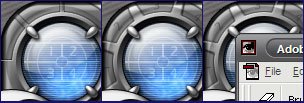Singularity: Corner Shortcuts
 Working on the graphics and concepts of the Singularity for LiteStep theme, I realized that the three shortcuts present in the upper-leftmost corner (shown in the first pane of the image at left) would be hard to find a purpose for. Thinking of what SacRat might say if he looked at this ("too many controls! Too complicated! Controls with similar functions should be grouped together! Group functions by what they control!), the realization dawned on me that making this shortcuts to typical LiteStep E-vars would be really random. That's what the fold-out shortcuts above the system tray should be used for.
Working on the graphics and concepts of the Singularity for LiteStep theme, I realized that the three shortcuts present in the upper-leftmost corner (shown in the first pane of the image at left) would be hard to find a purpose for. Thinking of what SacRat might say if he looked at this ("too many controls! Too complicated! Controls with similar functions should be grouped together! Group functions by what they control!), the realization dawned on me that making this shortcuts to typical LiteStep E-vars would be really random. That's what the fold-out shortcuts above the system tray should be used for.The way the theme currently works, the upper 30px and the left 30px of the desktop are reserved for the taskbar and system tray. When an application window is full-sized, it covers up the graphic VWM, precluding mouse-click access to other virtual desktops. In the 2003 incarnation of this theme this function was compensated for by the inclusion of buttons above the tray (then at the upper-right corner of the desktop) directly accessing each virtual desktop. Since the tray was moved in this remake, this location is no longer available for shortcuts.
The little SacRat that sits on my right shoulder then piped in "Make the existing 3 shortcut buttons into 4 and have THEM access different virtual desktops!" This was quickly countered by the Goat-Demon which sits on my left shoulder who barked "Make it more complicated, Mortal!" Needless to say, I gave in to the virtual SacRat. The second pane in the image above shows what resulted, 4 buttons to quickly access different VWMs when an application is maximized. Of course, VWM switching will also be an option users can select for the configurable corner mouse hotspots, although not everyone will select that option, necessitating an alternate method of switching desktops.
Next focus: Get all current theme shortcuts functional. Also need to put together the lower-right corner control module for media controls. I want it to be able to control either WinAmp or iTunes (since the iTunes module is available, and I haven't touched WinAmp in years).
REQUEST: It's becoming time to start scripting this thing. Anyone interested in doing some scripting for this? I can do it if I have to, but I really prefer not to. I'm kind of a sloppy, inelegant coder.









